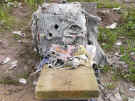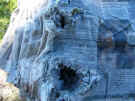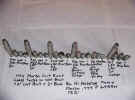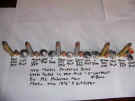![]()
Marlin's .444 Outfitter
Hunting, Handloads and Penetration Tests
By Al Anderson
The .444 Marlin has been with us for almost 40 years now. It came out in 1964 when I was four years old. A year or so before the .444 came out there was a wildcat that was very similar to the 444. It was based on the .30/40 Krag case blown out to .44 caliber. Some gunsmiths were chambering it in Winchester 94's and Marlin 336's and it created quite an interest in Leverguns that used a big straight walled .44 caliber case. (webmaster's note: that wildcat cartridge was the .44 Van Houten Super. It gave ballistics almost identical to the .444)
When the .444 came along it was a case-design all its own, and although similar it wasn't a copy of the wildcat round. The very first Marlin .444's came with a Monte Carlo pistol gripped stock and a 1 in 38" twist 24" barrel (later changed to a 22" barrel). Although some like a levergun with Monte Carlo stock they never really appealed to me. But that's just me. If someone out there didn't like pistol gripped stocks on their leverguns Marlin wouldn't be still making them.
Another thing I didn't like..... the only ammo loaded for it was the Remington 240 JSP. This is the same bullet used in .44 mag ammo. For a long time there were no suitable bullets available to the handloader either. I've heard of Remington 265 grain ammo but I'd never seen any. (Besides 265 gr. wasn't heavy enough for me.) I guess that's why I never picked one up.
Over the years I've shot around a dozen deer with the 240 gr. bullet in .44 mag sixguns and carbines. After shooting a handful of deer with the .44 mag sixgun's and the Remington 240 JSP and JHP I foolishly tried the same bullet on a bear out of a Ruger Blackhawk 5 1/2" and darn near lost him. After tracking him through thick brush at dark thirty I was happy that I had pocketful of shells loaded with a Lyman 250 Keith bullet to finish the job. I wish I would have penetration-tested those 240 gr. bullets first on some big bones! I would have known they weren't the right bullet for bear. When I later did penetration tests with it I proved it wasn't up to big game if big bones were hit. And the bullet performed even worse at the .444's higher velocity.
I'm sure there have been guys that have taken big game with the .444 and the 240 grain load, but they were probably excellent shots that waited for a good shot behind the shoulder avoiding big bones. What I want is to be able to take a shot and not worry whether I'm hitting bone or not. Being a handloader that favors Keith and LFN style cast bullets (and also the fact that I've never lost a game animal with either bullet from a sixgun or levergun) I knew that the .444 would work better with them.
When the heavyweight bullets started coming along in the 80's from SSK (NEI), LBT and later RCBS and Lyman, I had very good luck with them. In the .41 mag I used 250's, in the .44 mag 300-320's and 320's in the .45 Colt. I often thought I could make the 300- 360 grain LFN's work in the .444 but always heard that the slow 1 in 38" twist wouldn't stabilize the long heavy bullets. With that in mind I figured I'd just stick to shooting the .45-70's that work so well on big game with heavy bullets.
Then in 1999 Marlin brought out the .444 Model P Outfitter
with 18 1/2" barrel that had a faster 1 in 20" twist and straight
stock. I had to pick one up! The only thing I didn't like was the
ported barrel. I slicked up the action, and took out the trigger creep and
then shot several thousand rounds through it. Shooting it as well as the
.45-70 Guide gun and .450 Marlin Guide gun (both with porting) I found
they all shot so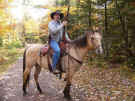 great I decided I could overlook the porting. I understand now that the porting is an option ....oh well
....too late for me. Now if they would just trim up the
forearm....... From the photo you can see how well it scabbards when
ahorseback and along with a companion .44 sixgun a guy is in pretty good shape
to take on just about anything.
great I decided I could overlook the porting. I understand now that the porting is an option ....oh well
....too late for me. Now if they would just trim up the
forearm....... From the photo you can see how well it scabbards when
ahorseback and along with a companion .44 sixgun a guy is in pretty good shape
to take on just about anything.
I was shocked to see the Outfitter wasn't listed in Marlin's 2003 catalog. I really like the short barreled straight stocked Outfitter and now all they show is the pistol gripped 22" model! One of my favorite Marlins is the early 70's 95 in .45-70 version with straight stock and 22" barrel.
I believe the .444 Marlin is a fairly short ranged cartridge for use up to 200 yards or so while hunting. (Longer if you just want to spend the day shooting rocks or long range targets). I also believe the Outfitter is at its best when hunting afoot in thick brush, or when in bear country for those that don't like to or can't carry a sixgun. It goes over the shoulder pretty slick with a sling. Although the .444 doesn't have the power of a heavy loaded .45-70 I believe it is a good round for someone that doesn't like the recoil of the .45-70. The recoil of the .444 is noticeably less with 340's than the .45-70 with heavy 400 grain plus loads. To hunt certain big game critters you need a big gun. You have to shoot a lot to learn to get used to recoil and to be able to shoot accurately or you shouldn't bother going after them. When my young daughter is ready to hunt bear I'll get her started shooting the .444.
Another good reason for a .444 is for someone that shoots a .44 sixgun and would like a carbine with more power than a .44 mag carbine to go along with it. You can use your .44 sixgun bullets in the .444 cartridge for plinking or lighter game. As you'll see from the upcoming loads the .444 can be loaded down with 240 grain cast bullets and can be a lot of fun for just plinking or for taking smaller game. I don't know if Marlin will be bringing the Outfitter back or not but if you want one I wouldn't wait too long or the shelves of the gun shops are going to be drying up.
Before I had Ballisti-Cast (www.ballisti-cast.com) make me a heavyweight mold for the .444 (a 340 LFNGC) I was using bullets from my sixgun molds. To use them there are a couple of things you have to do to make them work. In my rifle the longest OAL I use so it still feeds and chambers good is 2.555. With my LBT LFN's in weight 300-365 grain if you crimp in the crimp groove they will be too long to function. Same goes for the Keith style SWC GC 290-320 grain depending on alloy.
With the LFN's you can either trim your brass back and crimp in the groove or seat to the proper OAL of 2.555 and crimp in place with a Lee Factory Crimp Die. I have used both methods but I like the Lee factory crimp die the best. That way you don't have odd length brass and it saves you a lot of trimming.
With the Keith-type bullet, the nose from crimp groove is too long but you can crimp over the front driving band and they work fine. Just make sure you are using a charge of powder that comes up to the base of the bullet or when they are loaded in the magazine they can be pushed back into the case from heavy recoil. Bullets like the production cast 240 SWC from the Magma molds are short enough in the nose so they can be crimped in the crimp groove and function well for a plinking load. With those you don't have to worry about them pushing back into the case.
My favorite bullet in the .444 is the mold Ballisti-Cast
made for me that casts a 340 LFN GC. It has two crimp grooves and I use it as a
heavy bullet in the Ruger .44 Mag sixguns. It shoots and penetrates
well. I have shot Caribou and Hogs with this bullet and it has always
fully penetrated. The animals didn't live long after being hit. I shot two
Caribou with it, one at 25 yards and the other one at 200 yards. When hit
behind the shoulder they weren't on their feet very long. The bullets gave good
exit holes and heavy blood loss. The load I used on the Caribou was the 340 LFN
GC cast out of 7/2 Alloy, loaded over 38 grains of IMR 4198. The
velocity was 1834 fps.
penetrated. The animals didn't live long after being hit. I shot two
Caribou with it, one at 25 yards and the other one at 200 yards. When hit
behind the shoulder they weren't on their feet very long. The bullets gave good
exit holes and heavy blood loss. The load I used on the Caribou was the 340 LFN
GC cast out of 7/2 Alloy, loaded over 38 grains of IMR 4198. The
velocity was 1834 fps.
 The hogs I shot also died quickly and bled well with
The hogs I shot also died quickly and bled well with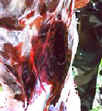 the
same load. In the photo with the skinned hog, the exit hole is from a 365 LBT
LFNGC loaded over 36 grains of IMR 4198. The velocity was 1819 fps.
the
same load. In the photo with the skinned hog, the exit hole is from a 365 LBT
LFNGC loaded over 36 grains of IMR 4198. The velocity was 1819 fps.
Now that Veral Smith of LBT (http://www.hanned.com/lbt/lbt.htm) is making molds again I may have him make me up a mold with a bullet weight of 350-380 or so with a proper crimp groove. This should work very well. I think my tests show that this would be a very good big game bullet. It should be made with a .340 nose to crimp groove length. I've had good luck with bullets cast out of 7/2 alloy or 50/50 wheelweight/ linotype or just straight linotype. I size them .430 and that works best in my rifle. It wouldn't hurt to experiment with size in your rifle as it does make a big difference sometimes.
Powders that have worked well for me in the .444 are, Unique for light plinking loads with the cast sixgun bullets, and IMR 4198. The best all around powder for good velocity and accuracy has been IMR 4198. Other powders I've used are, IMR 30-31, H322 and H Varget. Although some of the loads with those powders have been good I always go back to IMR 4198.
Here are some of the loads I like to shoot in the .444 for anything from just plinking to deer, hogs, blackbear and caribou. The little carbine with peep sights has been unbelievable the groups it shoots at 100 yards.
A. Light loads.
Using any of the 250 grain Keith sixgun bullets from Lyman, H&G (now Ballisti-Cast), RCBS, or LBT molds with 15 grains of A Unique. The bullet seated and crimped over front driving band. These will shoot into and inch or less at 25 yards and velocity will be from 1450-1500 FPS. Good plinking and deer medicine.
B. Jacketed bullet loads for Deer, Antelope, and other thin skinned game without big bones.
Remington 240 JSP 45 grains IMR 4198 Velocity 2008 ES 27 SD 10 5 shots 100 yards 1 1/4"
Hornady 265 JFP 43 grains IMR 4198 Velocity 2031 ES 34 SD 14 5 shots 100 yards 1 3/16"
Speer 270 Gold Dot 43 grains IMR 4198 Velocity 2008 ES 14 SD 5 5 shots 100 yards 1 1/8"
Speer 270 Gold Dot 52 grains H 322 Velocity 1990 5 shots 100 yards 1 7/8"
Speer 300 Plated Soft Point 43 grains IMR 4198 Velocity 2106 ES 28 SD 11 4 shots 100 yards 1 11/16"
Speer 300 Plated Soft Point 50 grains H322 Velocity 2030 5 shots 100 yards 1 3/4"
C. Heavy Cast bullet loads where penetration is needed on big game with big bones, such as Moose or Elk.
290 Keith Style SWC GC Linotype alloy 40 grains IMR 4198 Velocity 2007 5 shots 100 yards 1 13/16"
325 LBT LFN GC 40 grains IMR 4198 velocity 1970 4 shots 100 yards 1 5/16"
340 Ballisti-cast LFN GC 7/2 alloy 38 grains IMR 4198 velocity 1834
330 Ballisti-cast LFN GC Linotype alloy 38 grains IMR 4198 Velocity 1900 3 shots 100 yards 1 1/4"- 1 3/8"
365 LBT LFNGC 36 IMR 4198 velocity 1819 5 shots 100 yards 2 1/8"
When you are testing loads, changing bullet weight and velocity will change your point of impact by quite a bit. With the 240 Remington JSP at 2190 sighted on at 100 yards, the 265 Hornady and 270 Speer will be 7-8" lower. The 320's and 340's at 1800-1900 will be another 7-8" lower. Make sure and have lots of paper to be able to find your bullet holes when switching loads and move your sights to adjust for this.
Listed below are some of the bullets I've tested in wet print and wet print plus bone. While this is not going to be exactly how they will work on game it does show a trend as to penetration and how they well they hold together.
The test in bone was with 2" wet print then 2" cow bone and then wet print. The number listed for cow bone and wet print is for total penetration combined, bone and wet print.
In all fairness to the jacketed bullets tested, some of them are bullets intended for .44 mag sixgun velocity loads. But I tested them because some handloaders are using them and I wanted to show how they hold up. Maybe this will keep someone from going after something too big with the wrong bullet. Some handloaders are pushing the bullets even harder than I did with higher velocity. If the bullet isn't going to hold up you gain nothing.
Remember - The velocity listed here is for the 18 1/2" barrel. Velocity can run as much as 100 FPS faster out of the longer barrels! The bullets tested were shot at close range as I want to know how they will act if some big critter was going to take a bite out of me. If you are using a longer barrel than mine you can figure this would be the impact velocity at 50 yards or more. Bullets listed are in order of weight.
240 Remington JSP / 47 grains IMR 4198 / Velocity 2225. Penetration Wet print 13" expanded to 1.35 / Recovered weight 215 grains. Penetration Wet print and cow bone, falls apart in bone - destroys bullet with just small pieces found.
265 Hornady JFN / 43 grains IMR 4198 / Velocity 2031. Penetration in wet print 16 1/2" expanded to .960 / Recovered weight 242 grains. Penetration in Bone and print combined 7" expanded to .810 Recovered weight 226 grains.
270 Speer Gold Dot JFN / 43 grains IMR 4198 / velocity 2008. Penetration wet print 18" expanded to.780 / Recovered weight 192 grains. When shot into the print and bone bullet falls apart in the bone with only small pieces found.
290 Keith Style SWC GC Linotype alloy / 40 grains IMR 4198 velocity 2007 / Penetration wet print 24" expanded to .450 Recovered weight 226 grains. Penetration in print and bone 21" expanded to .500 recovered weight 193 grains.
300 LBT WLN GC / 43 IMR 4198 / velocity 2092 / Penetration wet print 22" expanded to .495 / Recovered weight 182 grains. Penetration print and bone 18" expanded to .460 recovered weight 170 grains. Note: Big entrance hole and cut good hole straight through.
300 Nosler JHP / 43 IMR 4198 / velocity 2078 / Penetration wet print 13" expanded to .835 / Recovered weight 199 grains. Jacket core separation. Did not test in bone no sense.
300 Hornady XTP HP / 43 grains IMR / 4198 velocity 2060 penetration wet print 12" expanded to 1.090 / Recovered weight 228 grains. Did not test in bone.
300 Speer Plated Soft Point / 43 grains IMR 4198 / velocity 2106 / Penetration wet print 14" expanded to .905 / Recovered weight 290 grains. Penetration print and bone 10" expanded to .955 recovered weight 284 grains and bullet stayed together.
325 LBT LFN GC / 40 grains IMR 4198 / velocity 1970 Penetration wet print 18" expanded to .710 / Recovered weight 278 grains. Penetration print and bone 16" expanded to .450 recovered weight 181 grains.
330 Ballisti-cast LFN GC Linotype alloy / 38 grains IMR 4198 velocity 1900 / penetration wet print 28" expanded to .440 Recovered weight 216 grains. Penetration print and bone 17" expanded to .465 recovered weight 222 grains.
340 Ballisti-cast LFN GC 7/2 alloy / 38 grains IMR 4198 velocity 1849 / penetration wet print 27" expanded to .460 Recovered weight 225. Penetration print and bone 19" expanded to .520 recovered weight 162 grains.
365 LBT LFN GC Linotype alloy / 36 grains IMR 4198 / velocity 1813 / penetration wet print 38" no expansion just flattened nose some what. / Recovered weight 353 grains mainly from gas check loss. Bullet looks unfired except rifling grooves. Penetration print and bone 20" expanded to .580 recovered weight 295 grains.
As you can see from the penetration tests the Jacketed bullets would not be the greatest on heavy game. If you had no choice and had to shoot a jacketed bullet on big game the Speer 300 plated soft point held up the best. Next would be the 265 grain Hornady. They both made it through the bone.
The big 365 LFN GC did the best on print and bone and also did a very good job on the two hogs that were shot with it, as you can see from the photo. Those big flat nosed bullet make good holes contrary to what is said at times. If I had to use the .444 on really big game this would be my bullet of choice.
The 330-340 LFNGC will do a good job on most game and it has worked well for me. I like Keith and LFN style bullets and have used them on game from several different calibers. They have always worked well. I admit to not using many WFN bullets and have only shot two game animals with them. They worked very well, but I don't think they shoot as good for long range and that's my main reason for not using them. It sure is nice to be able to shoot at that long range rock, stump or clump of sagebrush when you want so I always felt handicapped with them. As you can see from the photo the difference of the entrance hole from the Keith and the WFN, the WFN is a lot larger. After seeing that in both sixguns and leverguns, for shots under 100 yards they would be the medicine.
I've done all kinds of test with .45-70 bullets after seeing how well a big 540 WFN GC from a ballisti-cast mold does in wet print and bone and one hog it's going to get a closer look. I might have to start testing some WFN on some other game. I've tested them on paper and have loads for them so I will have to put them to work. That 300 WLN GC would be a dandy on deer and like game as you could count on good blood loss.
When I tested plain based bullets for accuracy the groups ran from 4" to as large as 12" at 100 yards with velocities that were between 1800-2000 FPS. With some of the other powders I tried, groups ran from 2 1/2" - 4" at 100 yards.
Another thing to remember is, penetration with cast bullets should be done with with good flat noses so they can cut their way though instead of just passing through like a round nose does. A guy that doesn't want to shoot cast bullets should get bullets from one of the custom makers. Have them make a big heavy jacketed bullet with a good large flat nose. I wish I would have had some to run through the test, but I had to use what I had on hand.
As for buying bullets for the non caster, get ahold of Kelly Brost of Cast Performance (www.castperformance.com) for good bullets. I believe he has a bullet similar to the one I shoot.
I've also heard of Factory Ammo that's out there that has bullets to get the job done and I would have liked to have tested some. I had most of this done right after I got the new Marlin catalog and there was no .444 in there listed as the Outfitter. That's why I wrote this up ..... its too good to loose. And with my neck on heal yet I couldn't test the factory ammo for awhile anyway. When I heal up - and I hope its soon - maybe I can get some of that ammo and give it a test. I'll let you know how that goes. Its hard to beat good heavy factory ammo for the guy that doesn't handload. You don't have to put up with just the 240 grain deer load. The custom loading outfits can put the right heavyweight bullet in their ammo suited to big game.
Well, I hope this test answers a lot of the questions on how bullets hold up and what type to use. As for the powder charges, they were looked up in a variety of books and are safe in my gun but like any kind of hand loading, don't start with my load. Back off couple of grains to be safe and then work up to what's safe accurate and works best in your Rifle.
The more I shoot the .444 the more I like it. I'm not going to get rid of my .45-70's but hopefully the .444 will be around for a long time to come, its just too good to die. And I've got a scabbard that it will always have room in it for the .444.
I had planned on having this out before summer so you could work up the proper loads in time before hunting season got here but maybe there is time yet. If not there's always next year. There may be even a few new bullets out there since I wrote this so look around.
If you have an Outfitter have fun with it and if not, good luck in finding one. Get out there and put it to the test as you can see its up to it for its 40th birthday. It didn't just get older ---- it got better.
